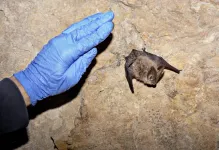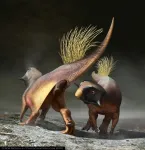INFORMATION:
Even a small amount of gender bias in hiring can be costly to employers
2021-01-19
(Press-News.org) CORVALLIS, Ore. - Tiny amounts of gender bias in employee hiring decisions contribute to concerning rates of discrimination and productivity losses that together represent significant costs, financial and otherwise, for employers, a new study from Oregon State University has found.
Gender bias is a subtle, unintentional preference for one gender over the other. Despite significant efforts to reduce bias in hiring over the last several decades, it continues to persist and pose potential problems for companies, said Jay Hardy, an assistant professor of management in OSU's College of Business and lead author of the study.
"The research has long shown bias exists. This study shows that it matters," Hardy said. "When carried through the hiring decision-making process, tiny amounts of bias will balloon into a high probability of discriminatory hiring outcomes in the eyes of the law, which also has important financial consequences for companies that end up hiring less-qualified candidates.
"The message of this study is that you can't ignore gender bias, even if you think its influence is so small as to not be concerning. Society generally recognizes bias as a moral issue, but we are now learning the extent to which it is a financial and strategic issue, as well."
The findings were published today in the Journal of Management. Co-authors on the paper are Richard Martell and Andy Olstad of Oregon State and Kian Siong Tey, Wilson Cyrus-Lai and Eric Luis Uhlmann of INSEAD, one of the world's largest graduate business schools, with locations in Europe, Asia, the Middle East and North America.
Hardy's research focuses on areas of human resources, including employee recruitment and selection and systematic bias in hiring. His goal for the study was to better understand the effects gender bias in hiring might have for employers.
"Bias is a problem ingrained in us. It is systematic," Hardy said. "It's not typically about bad intent. It is a natural response of human beings to make sense of our complex world by taking mental shortcuts. However, these cognitive shortcuts can have big consequences for us when high stakes rewards like a sought-after job are on the line. Our goal is to better understand it so we can find solutions."
Hardy and his colleagues first reviewed about 30 years of studies on gender bias and hiring in the workplace. The good news is that there appears to be less gender bias effect than there used to be. A couple of decades ago, gender bias influenced about 4% of hires. Today bias influences 1% or possibly fewer hires, Hardy said.
"The science shows that the effects of gender bias on hiring are very small," Hardy said. "In broad strokes, it seems like hiring decisions are actually pretty fair - certainly more fair than they used to be."
To better understand the impact this bias has and what it means for companies, Hardy and his colleagues ran a series of computer simulations. The researchers found that even a small amount of bias in hiring decisions can lead to discriminatory action against job candidates, putting companies at risk of costly legal action. They also found that biased hiring decisions can be costly for companies because a less-qualified candidate may not be successful in the position.
For example, a typical Fortune 500 company that hires 8,000 new employees a year with a 1% gender bias effect can expect 32 additional failed hires and many more sub-optimal hiring decisions, resulting in productivity losses of about $2.8 million per year. A 4% bias effect would lead to an additional 192 failed hires and an additional $17 million in lost productivity.
The study focused specifically on gender, but Hardy said it is likely that other types of bias would have similar or even bigger impacts. Past research has demonstrated that racial bias effects in hiring are much larger than they are for gender, so it is reasonable to think there would be more discrimination and more costs for employers as a result, he said.
"My estimates for gender bias were conservative and my simulations modeled near-optimal hiring conditions, so the impact of gender bias is likely to be higher in many real-world hiring contexts than my study indicates," Hardy said.
Hardy and his colleagues also simulated the impacts of some common methods for reducing gender bias in hiring, such as targeted recruiting efforts to build a bigger pool of female candidates, and found those methods still pose challenges.
"The targeted recruitment of highly qualified candidates can increase representation, but if you're not fixing the underlying bias problem, these methods do not address discrimination and can lead to other issues, including employee dissatisfaction," Hardy said.
Companies looking to reduce gender bias in their hiring processes should look for ways to remove human judgments from the process as much as possible, Hardy said. Interviews are one of the most common but least objective hiring tools, he noted. Future work by Hardy will further explore how to address bias in hiring and other employment decisions.
"Hiring is always going to be an imperfect process because human beings are complicated," Hardy said. "But the gold standard for any hiring manager should be to be as objective as possible in the hiring process."
ELSE PRESS RELEASES FROM THIS DATE:
Disease threatens to decimate western bats
2021-01-19
BOZEMAN, Montana (January 19, 2021) - A four-year study recently published in Ecology and Evolution concludes that the fungal disease, white-nose syndrome, poses a severe threat to many western North American bats.
Since it was first detected in 2006, white-nose syndrome has killed millions of bats in eastern and central North America. The spread of the fungal pathogen that causes white-nose syndrome in hibernating bats has reached several western U.S. states, mostly likely through bat-to-bat spread, and is presently threatening western species.
Bats with white-nose syndrome have fungus growing on their nose and wings, as the name implies, but the fungal infection also triggers a higher frequency of arousals from hibernation. ...
Where do our minds wander? Brain waves can point the way
2021-01-19
Anyone who has tried and failed to meditate knows that our minds are rarely still. But where do they roam? New research led by UC Berkeley has come up with a way to track the flow of our internal thought processes and signal whether our minds are focused, fixated or wandering.
Using an electroencephalogram (EEG) to measure brain activity while people performed mundane attention tasks, researchers identified brain signals that reveal when the mind is not focused on the task at hand or aimlessly wandering, especially after concentrating on an assignment.
Specifically, increased alpha brain waves were detected in the prefrontal cortex of ...
Counting elephants from space
2021-01-19
For the first time, scientists have successfully used satellite cameras coupled with deep learning to count animals in complex geographical landscapes, taking conservationists an important step forward in monitoring populations of endangered species.
For this research, the satellite Worldview 3 used high-resolution imagery to capture African elephants moving through forests and grasslands. The automated system detected animals with the same accuracy as humans are able to achieve.
The algorithm that enabled the detection process was created by Dr Olga Isupova, a computer scientist at the University of Bath in the UK. The project was a collaboration with the UK's University of Oxford and the University of Twente in the Netherlands.
Dr ...
5G doesn't cause COVID-19, but the rumor it does spread like a virus
2021-01-19
People's fear of 5G technology is rational. Such technology does emit radiation, even if it's at low levels. But 5G isn't all that different from 4G, and it certainly doesn't cause COVID-19 despite such rumors having spread rapidly across the globe.
Researchers need to better understand how misinformation like this spreads in order to hone their intervention efforts and prevent misinformed perspectives from taking root. In society's virtual world, preventing technological misinformation, in particular, is important now more than ever.
A research team led by Elaine Nsoesie, a Hariri Institute Faculty Fellow, investigated how COVID-19 misinformation proliferated using ...
Study in twins identifies fecal microbiome differences in food allergies
2021-01-19
A new study out of the University of Chicago and Stanford University on pairs of twins with and without food allergies has identified potential microbial players in this condition. The results were published on Jan. 19 in the Journal of Clinical Investigation.
The study grew out of prior research in the Nagler laboratory at UChicago on the fecal microbiota in infants. By transplanting fecal microbes from healthy and food-allergic infants to germ-free mice (who do not possess a microbiome), investigators found that the healthy infant microbiota was protective against the development ...
New clues help explain why PFAS chemicals resist remediation
2021-01-19
The synthetic chemicals known as PFAS, short for perfluoroalkyl and polyfluoroalkyl substances, are found in soil and groundwater where they have accumulated, posing risks to human health ranging from respiratory problems to cancer.
New research from the University of Houston and Oregon State University published in Environmental Science and Technology Letters suggests why these "forever chemicals" - so called because they can persist in the environment for decades - are so difficult to permanently remove and offers new avenues for better remediation practices.
The work focused on the interactions sparked when firefighters use ...
Fatty acid may help combat multiple sclerosis
2021-01-19
The abnormal immune system response that causes multiple sclerosis (MS) by attacking and damaging the central nervous system can be triggered by the lack of a specific fatty acid in fat tissue, according to a new Yale study. The finding suggests that dietary change might help treat some people with the autoimmune disease.
The study was published Jan. 19 in The Journal of Clinical Investigation.
Fat tissue in patients diagnosed with MS lack normal levels of oleic acid, a monounsaturated fatty acid found at high levels in, for instance, cooking oils, meats (beef, chicken, and pork), cheese, nuts, sunflower seeds, eggs, pasta, ...
Researchers discover mechanism behind most severe cases of a common blood disorder
2021-01-19
With a name like glucose-6-phosphate dehydrogenase deficiency, one would think it is a rare and obscure medical condition, but that's far from the truth. Roughly 400 million people worldwide live with potential of blood disorders due to the enzyme deficiency. While some people are asymptomatic, others suffer from jaundice, ruptured red blood cells and, in the worst cases, kidney failure.
Now, a team led by researchers at the Department of Energy's SLAC National Accelerator Laboratory have uncovered the elusive mechanism behind the most severe cases of the ...
Eggs reveal what may happen to brain on impact
2021-01-19
WASHINGTON, January 19, 2021 -- What causes brain concussions? Is it direct translational or rotational impact? This is one of the research areas currently being explored by Qianhong Wu's lab at Villanova University.
Our brains consist of soft matter bathed in watery cerebrospinal fluid (CSF) inside a hard skull. An impact on the hard skull is transmitted through the thin layer of CSF within the subarachnoid space to the soft brain matter.
In Physics of Fluids, from AIP Publishing, Wu and co-authors Ji Lang and Rungun Nathan describe studying another system with the same features, an egg, to search for answers. An egg resembles the brain, because its soft yolk is bathed within a liquid egg white inside a hard shell.
Considering that in most concussive brain injuries, the skull does ...
All-purpose dinosaur opening reconstructed for first time
2021-01-19
For the first time ever, a team of scientists, led by the University of Bristol, have described in detail a dinosaur's cloacal or vent - the all-purpose opening used for defecation, urination and breeding.
Although most mammals may have different openings for these functions, most vertebrate animals possess a cloaca.
Although we know now much about dinosaurs and their appearance as feathered, scaly and horned creatures and even which colours they sported, we have not known anything about how the vent appears.
Dr Jakob Vinther from the University of Bristol's School of Earth Sciences, along with colleagues Robert Nicholls, a palaeoartist, and Dr Diane Kelly, ...



